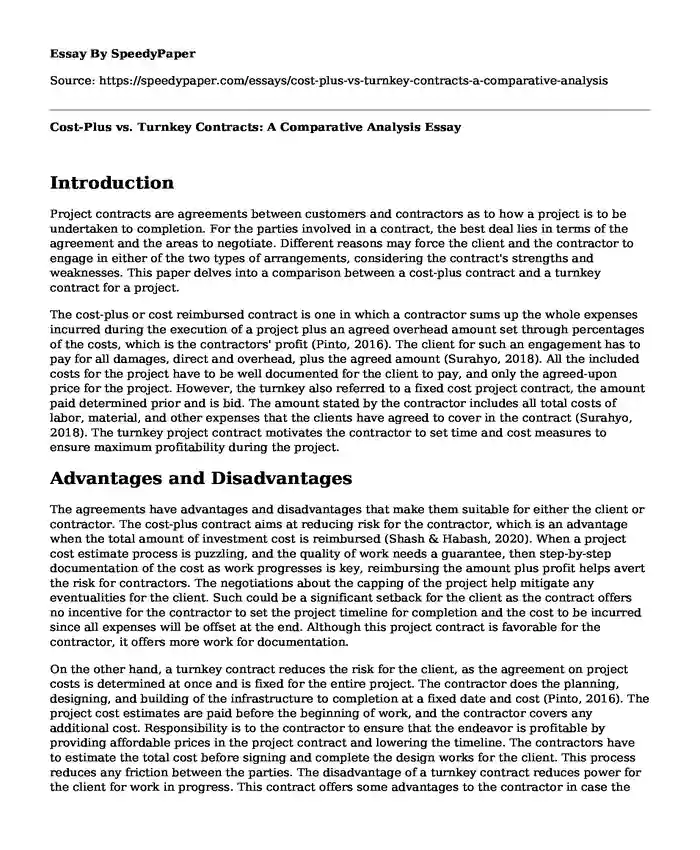
| Type of paper: | Essay |
| Categories: | Project management |
| Pages: | 3 |
| Wordcount: | 733 words |
Introduction
Project contracts are agreements between customers and contractors as to how a project is to be undertaken to completion. For the parties involved in a contract, the best deal lies in terms of the agreement and the areas to negotiate. Different reasons may force the client and the contractor to engage in either of the two types of arrangements, considering the contract's strengths and weaknesses. This paper delves into a comparison between a cost-plus contract and a turnkey contract for a project.
The cost-plus or cost reimbursed contract is one in which a contractor sums up the whole expenses incurred during the execution of a project plus an agreed overhead amount set through percentages of the costs, which is the contractors' profit (Pinto, 2016). The client for such an engagement has to pay for all damages, direct and overhead, plus the agreed amount (Surahyo, 2018). All the included costs for the project have to be well documented for the client to pay, and only the agreed-upon price for the project. However, the turnkey also referred to a fixed cost project contract, the amount paid determined prior and is bid. The amount stated by the contractor includes all total costs of labor, material, and other expenses that the clients have agreed to cover in the contract (Surahyo, 2018). The turnkey project contract motivates the contractor to set time and cost measures to ensure maximum profitability during the project.
Advantages and Disadvantages
The agreements have advantages and disadvantages that make them suitable for either the client or contractor. The cost-plus contract aims at reducing risk for the contractor, which is an advantage when the total amount of investment cost is reimbursed (Shash & Habash, 2020). When a project cost estimate process is puzzling, and the quality of work needs a guarantee, then step-by-step documentation of the cost as work progresses is key, reimbursing the amount plus profit helps avert the risk for contractors. The negotiations about the capping of the project help mitigate any eventualities for the client. Such could be a significant setback for the client as the contract offers no incentive for the contractor to set the project timeline for completion and the cost to be incurred since all expenses will be offset at the end. Although this project contract is favorable for the contractor, it offers more work for documentation.
On the other hand, a turnkey contract reduces the risk for the client, as the agreement on project costs is determined at once and is fixed for the entire project. The contractor does the planning, designing, and building of the infrastructure to completion at a fixed date and cost (Pinto, 2016). The project cost estimates are paid before the beginning of work, and the contractor covers any additional cost. Responsibility is to the contractor to ensure that the endeavor is profitable by providing affordable prices in the project contract and lowering the timeline. The contractors have to estimate the total cost before signing and complete the design works for the client. This process reduces any friction between the parties. The disadvantage of a turnkey contract reduces power for the client for work in progress. This contract offers some advantages to the contractor in case the cost of material reduces during working on the project.
Conclusion
In conclusion, the cost-plus contract involves a contractor is summing the whole expenses incurred during the execution of a project plus an agreed overhead amount set as percentages of the costs, which is the contractors' profit. On the other hand, a turnkey contract reduces the risk for the client as the agreement on project cost is fixed from the beginning to completion of the project. To undertake any project requires informed decision-making. Not all projects are the same in their running. Therefore, each requires a separate agreement. For all parties to feel represented, there are negotiations and counteroffers before the signing of the contract. Parties involved in the deal must be vigilant with agreement terms of the contract to ensure the smooth running of the project.
References
Pinto, J. K. (2016). Project management: Achieving competitive advantage (4th ed.). New York, NY. Pearson.
Shash, A. A., & Habash, S. I. (2020). Construction contract conversion: An approach to resolve disputes. Journal of Engineering, Project, and Production Management, 10(3), 162-169. https://doi.org/10.2478/jeppm-2020-0018
Surahyo, A. (2018). Types of Construction Contracts. In Understanding Construction Contracts: Canadian and international conventions (pp. 45-52). Springer.
Cite this page
Cost-Plus vs. Turnkey Contracts: A Comparative Analysis. (2023, Sep 14). Retrieved from https://speedypaper.com/essays/cost-plus-vs-turnkey-contracts-a-comparative-analysis
Request Removal
If you are the original author of this essay and no longer wish to have it published on the SpeedyPaper website, please click below to request its removal:
- Free Essay Sample: Supply Chain Collaboration and Competitiveness
- Identification and Discussion of Major Dilemmas. Paper Example
- Free Essay: Effective Communication Systems Within an Organization
- Free Essay Example - Accenture Company
- Risk Factors among Employee Population - Essay Example
- Hazard Reduction - Essay Sample
- Free Paper Example on Global Warming
Popular categories




